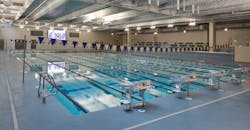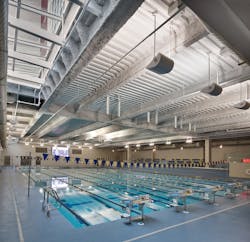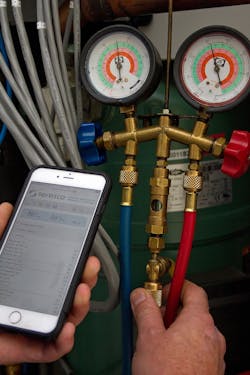Small Pond, Big Fish Find National Renown in IAQ
By RALPH KITTLER, P.E.
Dehumidified Air Solutions, Montreal QC
Queens University of Charlotte (NC) is a small, private college of 2,300 students, but its indoor competition pool has garnered a large amount of national recognition for its indoor air quality (IAQ) design.
For example, Jeff Dugdale, QU’s men’s and women’s swim coach who helped spearhead the indoor pool’s design, met in late 2018 with the lead counsel of the U.S. Senate Environment and Public Works Committee. The committee, as well as the U.S. Environmental Protection Agency (EPA) and Occupational Safety and Health Administration (OSHA), have shown an interest in QU’s pool as a potential model of good IAQ.
The EPA and OSHA are looking for answers to health issues, such as “Lifeguard Lung,” asthma and other respiratory irritants that experts suspect are developed and/or aggravated by indoor pool environments. Lifeguard Lung (granulomatous pneumonitis) in particular, is posing health risks with facility employees who spend the majority of their work hours in natatoriums. Although swimmers spend less time than lifeguards, asthma among swimmers is becoming an increasingly serious respiratory issue even with short pool exposure times.
Royal treatment: Ever since it opened in 2013, the 144,000-sq-ft Levine Center has revolved around its 33-m-long pool.
Besides governmental recognition, QU’s pool has also gotten the attention of the world’s best high school swimmers. Although it’s a Division II school in the Blue Grass Mountain Conference, QU successfully uses IAQ to recruit Division 1 level swimmers from around the world. Visiting parents of recruit candidates, especially those who regularly used breathalyzers at their high school swim meets, immediately notice QU’s superior IAQ and great water quality inside the pool area, according to Dugdale. The recruiting results are in Dugdale’s record. Both the men’s and women’s swim teams have won the NCAA Division II National Championships the last four years and were on par for a fifth championship at press time. Dugdale estimates 60 percent of his team could have gotten full scholarships from large Division I schools, but instead chose QU for the IAQ. Some team members hail from Europe where indoor pool IAQ standards are more stringent than the U.S.
How QU Created the Ultimate IAQ
There might be more aesthetic university pools, but few, if any, compare to a 33-meter-long stretch pool’s IAQ, according to Lea Burt, P.E., CEM, president of Mechanical Contractors Inc., (MCI), Charlotte, NC. MCI was the design/build contractor for the entire $30 million, 144,000-square-foot Levine Center for Wellness and Recreation that houses the 7,500-square-foot pool in a space-saving sublevel that’s 15 feet below grade and the ground level 2,500-seat basketball arena above it.
While many engineers may never design an indoor pool in their lifetime, Burt had previously designed several natatoriums. That experience was what Dugdale and Troy Luttman, AIA, campus architect and associate vice president of design and construction, needed to build what’s arguably one of the best indoor pools in the country today.
A successful natatorium environment with good indoor air quality is a synergy of five principles: 1) proper building materials and building envelope design; 2) effective air distribution; 3) the right mechanical HVAC equipment, 4) source capture of chemical gasses at the water surface; and 5) pool water chemistry. The latter discipline is actually more of a facility operations and maintenance issue than design concern. Good natatorium design is easily accomplished, according to Burt, if the design team follows the recommendations and precautions of Chapter 25 (“Mechanical Dehumidifiers and Related Equipment”) in ASHRAE’s Systems and Equipment Handbook.
Mobile controls allow remote monitoring of air quality and temperature, and facilitate trouble-shooting.
Unfortunately, the nation’s indoor pool facilities that don’t exhibit good IAQ often miss parts of ASHRAE’s recommendations and the five aforementioned design points. The Internet has dozens of horror stories about poor IAQ in natatoriums. For example, 2016 Olympic gold medalist swimmer Caeleb Dressel was transported to an emergency room with breathing problems during the 2013 USA Winter Junior National Championships due to facility IAQ problems, according to a report by Swimming World Magazine.
Knowing the dangers of poor IAQ, Dugdale and Burt insisted during design meetings that cutting costs on critical items such anti-corrosive building materials, expanded supply and return air distribution coverage, source capture and state-of-the-art mechanical equipment would affect the ultimate IAQ they were looking to achieve. The duo made several presentations during the project’s value engineering period to point out why certain building materials, designs and equipment were essential for project success. They also used evidence of IAQ failures in other pool designs.
Building Envelope & Materials
Burt collaborated with the project architect on the choice of building materials and assured certain installation techniques were applied properly. For example, Burt lobbied against the use of glass in the design, which adds a nice aesthetic but attracts condensation concerns. Another architectural precaution is assuring the vapor barrier envelopes the entire building pool area to prevent moisture migration. The contractor must install it without tears or broken seams, which can allow moisture exposure to attack the building’s structural materials.
Air Distribution
Air distribution is equally important, because conditioned air must be dispersed down to the breathing zone at deck level and pool surface level. Ideally, ductwork must be positioned approximately one foot away from exterior walls and windows to assure proper coverage that will prevent condensation. Return air is critical too. Burt recalls design committee value engineering conversations that would consolidate return air coverage, which can result in air stratification and short circuiting.
Source Capture
Chloramines, a toxic gas formed by the attachment of human waste and chlorine molecules in the pool water, is the main culprit in breathing problems. It’s a heavy gas that hovers above the water surface and can’t be totally eliminated in conventional pool ventilation designs. Burt minimized chloramines accumulation at QU by specifying six volumetric air changes per hour and combining it with a source capture contaminant device that’s integrated into one side of the pool gutter system. The 4,500-CFM source capture unit built draws chloramines off the water surface and exhausts it outdoors.
Outdoor air measurement as per ASHRAE Standard 62 guidelines has a baseline of 0.48-CFM/s.f. for a conventional pool water surface area and the deck area. Pools with spectator seating should add 7.5-CFM per spectator during events. Swimmers aren’t considered spectators and they are covered by the baseline calculation. Increasing outdoor air beyond the minimum requirement will significantly raise energy costs in the winter and potentially lower the relative humidity (RH) to a potentially chilling level below 50-percent.
Exhaust air is equally as important. Natatoriums run at a slightly negative pressure of 0.05 to 0.15-w.g., so that humid, chemical-laden air isn’t pushed outside the natatorium into other portions of the building. Generally, 110-percent outdoor air CFM is recommended. Source capture contaminant devices can figure into the exhaust air as direct exhaust or channeled to the dehumidifier for heat recovery to efficiently condition the incoming outdoor air. For spas, source capture exhaust often is done via conventional return air grilles directly above the highly agitated water.
Equipment Sizing
Like any project, the HVAC equipment needs proper sizing and typically is a DX-style mechanical dehumidifier that can heat, cool and dehumidify the space. Knowing the pool’s future activities was critical for Burt’s equipment sizing. Dugdale, who is also QU’s associate athletic director, head swim and aquatic director, wanted 54-percent (RH) supplied by a dehumidifier. He also wanted a heat recovery dehumidifier with free pool water heating to 80°F, while also cooling or heating the space to 76°F. That four-degree differential is quite a deviation from ASHRAE’s recommended two-degree differential between water and space temperature (typically 84°F air and 82°F water set points, for example) to minimize evaporation rates. These unorthodox set points certainly work, but result in higher evaporation rates and must be planned for during the design phase to properly size the mechanical equipment and maintain a space that’s comfortable for both swimmers and spectators.
In QU’s case, it uses two 24-ton dehumidifiers that were purposely configured to be piggy-backed together for cramped mechanical rooms. This makes staging easier and energy efficient, whether there’s a swim meet or just an off-hours practice with a few swimmers. Specifying two units also offers redundancy. Dugdale said his teams have never missed one practice due to a natatorium shutdown.
Pool water chemistry is typically a facility operations and maintenance issue, rather than a design consideration, but the consulting engineer should always monitor what water sanitization devices are implemented in the design. For example, UV water purification technology or other secondary water sanitation alternatives for reducing chlorine use and subsequently chloramines, could be suggested as part of the pool support equipment. Dugdale is so tuned into the IAQ, he instills a “culture of IAQ” which even emphasizes swimmer personal hygiene in and out of the pool, to help maintain a healthier climate.
Designing a good pool environment is only half the task. Burt also specified a dehumidifier that incorporates internet access, remote monitoring and analyzation through web-based browsers. Therefore, factory service professionals can access the equipment for adjustments, recalibration or troubleshooting to keep the unit operating efficiently and maintain the natatorium air comfort via PCs or smartphones. Factory technicians through remote monitoring can also help Burt’s service technicians troubleshoot when service issues arise.
Burt has the best explanation for putting function over aesthetics when designing a pool: “Institutions wanting these kind of pools (superior IAQ) should ask themselves if they want four national championships or a nice picture for a recruiting brochure. Then they should put their money in the right place.”
###################
Based in Montreal, the author is vice president at Dehumidified Air Solutions and co-founder of Seresco Technologies, an Ottawa-based mechanical dehumidifier manufacturer. Kittler is an ASHRAE Distinguished Lecturer and the reviser responsible for Chapter 25 (“Mechanical Dehumidifiers and Related Equipment”) for ASHRAE’s 2012 Systems and Equipment Handbook. He can be reached at [email protected].



